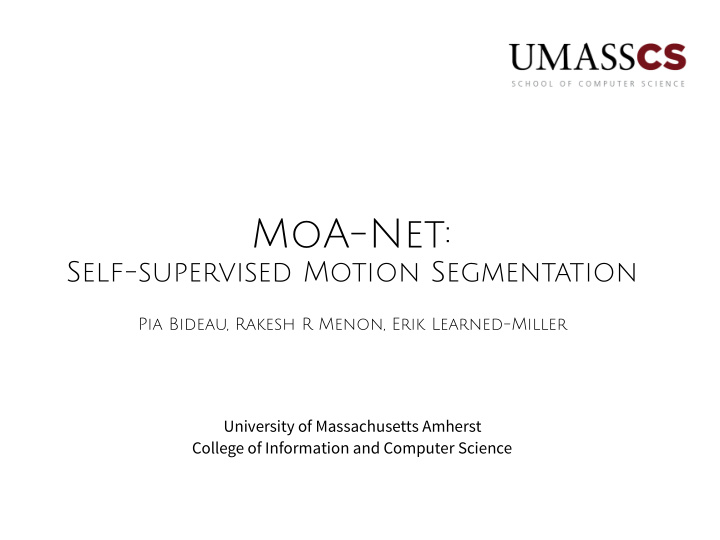



MoA-Net: Self-supervised Motion Segmentation Pia Bideau, Rakesh R Menon, Erik Learned-Miller University of Massachusetts Amherst College of Information and Computer Science
Motion Segmentation • P Bideau, E Learned-Miller, ECCV 2016: It’s moving! A probabilistic model for causal motion segmentation • P Bideau, A RoyChoudhury, R Menon, E Learned-Miller, CVPR 2018: The best of both worlds: Combining CNNs and geometric constraints for hierarchical motion segmentation • P Bideau, R Menon, E Learned-Miller, Workshop ECCV 2018: MoA-Net: Unsupervised Motion Segmentation
Overview Motivation How do humans know what is moving in the world and what is not? Approach: Motion Segmentation Rotation compensation Learning Motion Patterns: MoA-Net Results Future Research Questions
Motivation
Motivation stationary scene moving object no observer motion stationary scene moving object observer motion
Motivation stationary scene moving object no observer motion stationary scene moving object observer motion
Motivation stationary scene moving object no observer motion stationary scene moving object observer motion
Motivation All motions result in changes of the retinal image. What is the problem about retinal image motion? photoreceptors are slow motion detection in our brain is challenging Need to stabilize the image, to reduce retinal image motion
Motivation
Overview Motivation How do humans know what is moving in the world and what is not? Approach: Motion Segmentation Rotation compensation Learning Motion Patterns: MoA-Net Results Future Research Questions
Approach: Motion Segmentation MoA-Net optical flow rotation compensated angle field motion segmentation flow step 1: rotation compensation step 2: motion segmentation
Approach: Motion Segmentation MoA-Net MoA-Net optical flow rotation compensated angle field motion segmentation flow step 1: rotation compensation step 2: motion segmentation
Rotation Compensation rotation + translation optical flow magnitude is dependent on scene depth optical flow angle is dependent on scene depth translation optical flow magnitude is dependent on scene depth optical flow angle is independent of scene depth
Rotation Compensation only camera translation and object motion optical flow angle field
Motion Segmentation MoA-Net optical flow rotation compensated angle field motion segmentation flow step 1: rotation compensation step 2: motion segmentation
Motion Segmentation Definition Def.: Moving Object A moving object is a connected image region that undergoes some independent motion. The connected image region can be of any size and shape.
Motion Segmentation Generating training data
Motion Segmentation Generating training data Generating connected object regions. Splitting each object into n subregions. Assigning to each motion region a translational 3D direction. Smoothing motion boundaries inside moving objects. Adding random gaussian noise.
Motion Segmentation Generating training data Generating connected object regions. Splitting each object into n subregions. Assigning to each motion region a translational 3D direction. Smoothing motion boundaries inside moving objects. Adding random gaussian noise.
<latexit sha1_base64="JCr+BgiUPgFXbeORWr2WJARtAYE=">ACKnicbZBNSwMxEIazftb6VfXoJVjESrXsiqAXpeLFo4LbCm0ps2nWhmazSzIrlqW/x4t/xYsHRbz6Q0w/DlodCLy8zwyTeYNECoOu+HMzM7NLyzmlvLK6tr64WNzZqJU824z2IZ67sADJdCcR8FSn6XaA5RIHk96F0Oef2BayNidYv9hLciuFciFAzQWu3CRO7HIGe0ayJSAFBDUqHYa3crx/Qw9AvP9b36RSt7Y2pvzek7ULRrbijon+FNxFMqnrduG12YlZGnGFTIxDc9NsJWBRsEkH+SbqeEJsB7c84aVCiJuWtno1AHdtU6HhrG2TyEduT8nMoiM6UeB7YwAu2aDc3/WCPF8LSVCZWkyBUbLwpTSTGmw9xoR2jOUPatAKaF/StlXdDA0KabtyF40yf/FbWjiudWvJvjYvV8EkeObJMdUiIeOSFVckWuiU8YeSIv5I28O8/Oq/PhfI5bZ5zJzBb5Vc7XN6OdowU=</latexit> <latexit sha1_base64="JCr+BgiUPgFXbeORWr2WJARtAYE=">ACKnicbZBNSwMxEIazftb6VfXoJVjESrXsiqAXpeLFo4LbCm0ps2nWhmazSzIrlqW/x4t/xYsHRbz6Q0w/DlodCLy8zwyTeYNECoOu+HMzM7NLyzmlvLK6tr64WNzZqJU824z2IZ67sADJdCcR8FSn6XaA5RIHk96F0Oef2BayNidYv9hLciuFciFAzQWu3CRO7HIGe0ayJSAFBDUqHYa3crx/Qw9AvP9b36RSt7Y2pvzek7ULRrbijon+FNxFMqnrduG12YlZGnGFTIxDc9NsJWBRsEkH+SbqeEJsB7c84aVCiJuWtno1AHdtU6HhrG2TyEduT8nMoiM6UeB7YwAu2aDc3/WCPF8LSVCZWkyBUbLwpTSTGmw9xoR2jOUPatAKaF/StlXdDA0KabtyF40yf/FbWjiudWvJvjYvV8EkeObJMdUiIeOSFVckWuiU8YeSIv5I28O8/Oq/PhfI5bZ5zJzBb5Vc7XN6OdowU=</latexit> <latexit sha1_base64="JCr+BgiUPgFXbeORWr2WJARtAYE=">ACKnicbZBNSwMxEIazftb6VfXoJVjESrXsiqAXpeLFo4LbCm0ps2nWhmazSzIrlqW/x4t/xYsHRbz6Q0w/DlodCLy8zwyTeYNECoOu+HMzM7NLyzmlvLK6tr64WNzZqJU824z2IZ67sADJdCcR8FSn6XaA5RIHk96F0Oef2BayNidYv9hLciuFciFAzQWu3CRO7HIGe0ayJSAFBDUqHYa3crx/Qw9AvP9b36RSt7Y2pvzek7ULRrbijon+FNxFMqnrduG12YlZGnGFTIxDc9NsJWBRsEkH+SbqeEJsB7c84aVCiJuWtno1AHdtU6HhrG2TyEduT8nMoiM6UeB7YwAu2aDc3/WCPF8LSVCZWkyBUbLwpTSTGmw9xoR2jOUPatAKaF/StlXdDA0KabtyF40yf/FbWjiudWvJvjYvV8EkeObJMdUiIeOSFVckWuiU8YeSIv5I28O8/Oq/PhfI5bZ5zJzBb5Vc7XN6OdowU=</latexit> <latexit sha1_base64="JCr+BgiUPgFXbeORWr2WJARtAYE=">ACKnicbZBNSwMxEIazftb6VfXoJVjESrXsiqAXpeLFo4LbCm0ps2nWhmazSzIrlqW/x4t/xYsHRbz6Q0w/DlodCLy8zwyTeYNECoOu+HMzM7NLyzmlvLK6tr64WNzZqJU824z2IZ67sADJdCcR8FSn6XaA5RIHk96F0Oef2BayNidYv9hLciuFciFAzQWu3CRO7HIGe0ayJSAFBDUqHYa3crx/Qw9AvP9b36RSt7Y2pvzek7ULRrbijon+FNxFMqnrduG12YlZGnGFTIxDc9NsJWBRsEkH+SbqeEJsB7c84aVCiJuWtno1AHdtU6HhrG2TyEduT8nMoiM6UeB7YwAu2aDc3/WCPF8LSVCZWkyBUbLwpTSTGmw9xoR2jOUPatAKaF/StlXdDA0KabtyF40yf/FbWjiudWvJvjYvV8EkeObJMdUiIeOSFVckWuiU8YeSIv5I28O8/Oq/PhfI5bZ5zJzBb5Vc7XN6OdowU=</latexit> Motion Segmentation Generating training data Generating connected object regions. Splitting each object into n subregions. θ = atan ( − fV + yW, − fU + xW ) = Assigning to each motion region ) = atan ( − V 0 + yW, − U 0 + xW ) a translational 3D direction. Smoothing motion boundaries inside moving objects. Adding random gaussian noise.
<latexit sha1_base64="JCr+BgiUPgFXbeORWr2WJARtAYE=">ACKnicbZBNSwMxEIazftb6VfXoJVjESrXsiqAXpeLFo4LbCm0ps2nWhmazSzIrlqW/x4t/xYsHRbz6Q0w/DlodCLy8zwyTeYNECoOu+HMzM7NLyzmlvLK6tr64WNzZqJU824z2IZ67sADJdCcR8FSn6XaA5RIHk96F0Oef2BayNidYv9hLciuFciFAzQWu3CRO7HIGe0ayJSAFBDUqHYa3crx/Qw9AvP9b36RSt7Y2pvzek7ULRrbijon+FNxFMqnrduG12YlZGnGFTIxDc9NsJWBRsEkH+SbqeEJsB7c84aVCiJuWtno1AHdtU6HhrG2TyEduT8nMoiM6UeB7YwAu2aDc3/WCPF8LSVCZWkyBUbLwpTSTGmw9xoR2jOUPatAKaF/StlXdDA0KabtyF40yf/FbWjiudWvJvjYvV8EkeObJMdUiIeOSFVckWuiU8YeSIv5I28O8/Oq/PhfI5bZ5zJzBb5Vc7XN6OdowU=</latexit> <latexit sha1_base64="JCr+BgiUPgFXbeORWr2WJARtAYE=">ACKnicbZBNSwMxEIazftb6VfXoJVjESrXsiqAXpeLFo4LbCm0ps2nWhmazSzIrlqW/x4t/xYsHRbz6Q0w/DlodCLy8zwyTeYNECoOu+HMzM7NLyzmlvLK6tr64WNzZqJU824z2IZ67sADJdCcR8FSn6XaA5RIHk96F0Oef2BayNidYv9hLciuFciFAzQWu3CRO7HIGe0ayJSAFBDUqHYa3crx/Qw9AvP9b36RSt7Y2pvzek7ULRrbijon+FNxFMqnrduG12YlZGnGFTIxDc9NsJWBRsEkH+SbqeEJsB7c84aVCiJuWtno1AHdtU6HhrG2TyEduT8nMoiM6UeB7YwAu2aDc3/WCPF8LSVCZWkyBUbLwpTSTGmw9xoR2jOUPatAKaF/StlXdDA0KabtyF40yf/FbWjiudWvJvjYvV8EkeObJMdUiIeOSFVckWuiU8YeSIv5I28O8/Oq/PhfI5bZ5zJzBb5Vc7XN6OdowU=</latexit> <latexit sha1_base64="JCr+BgiUPgFXbeORWr2WJARtAYE=">ACKnicbZBNSwMxEIazftb6VfXoJVjESrXsiqAXpeLFo4LbCm0ps2nWhmazSzIrlqW/x4t/xYsHRbz6Q0w/DlodCLy8zwyTeYNECoOu+HMzM7NLyzmlvLK6tr64WNzZqJU824z2IZ67sADJdCcR8FSn6XaA5RIHk96F0Oef2BayNidYv9hLciuFciFAzQWu3CRO7HIGe0ayJSAFBDUqHYa3crx/Qw9AvP9b36RSt7Y2pvzek7ULRrbijon+FNxFMqnrduG12YlZGnGFTIxDc9NsJWBRsEkH+SbqeEJsB7c84aVCiJuWtno1AHdtU6HhrG2TyEduT8nMoiM6UeB7YwAu2aDc3/WCPF8LSVCZWkyBUbLwpTSTGmw9xoR2jOUPatAKaF/StlXdDA0KabtyF40yf/FbWjiudWvJvjYvV8EkeObJMdUiIeOSFVckWuiU8YeSIv5I28O8/Oq/PhfI5bZ5zJzBb5Vc7XN6OdowU=</latexit> <latexit sha1_base64="JCr+BgiUPgFXbeORWr2WJARtAYE=">ACKnicbZBNSwMxEIazftb6VfXoJVjESrXsiqAXpeLFo4LbCm0ps2nWhmazSzIrlqW/x4t/xYsHRbz6Q0w/DlodCLy8zwyTeYNECoOu+HMzM7NLyzmlvLK6tr64WNzZqJU824z2IZ67sADJdCcR8FSn6XaA5RIHk96F0Oef2BayNidYv9hLciuFciFAzQWu3CRO7HIGe0ayJSAFBDUqHYa3crx/Qw9AvP9b36RSt7Y2pvzek7ULRrbijon+FNxFMqnrduG12YlZGnGFTIxDc9NsJWBRsEkH+SbqeEJsB7c84aVCiJuWtno1AHdtU6HhrG2TyEduT8nMoiM6UeB7YwAu2aDc3/WCPF8LSVCZWkyBUbLwpTSTGmw9xoR2jOUPatAKaF/StlXdDA0KabtyF40yf/FbWjiudWvJvjYvV8EkeObJMdUiIeOSFVckWuiU8YeSIv5I28O8/Oq/PhfI5bZ5zJzBb5Vc7XN6OdowU=</latexit> Motion Segmentation Generating training data Generating connected object regions. Splitting each object into n subregions. θ = atan ( − fV + yW, − fU + xW ) = Assigning to each motion region ) = atan ( − V 0 + yW, − U 0 + xW ) a translational 3D direction. Smoothing motion boundaries inside moving objects. Adding random gaussian noise.
Recommend
More recommend